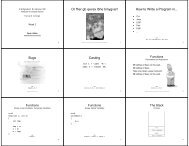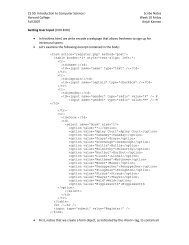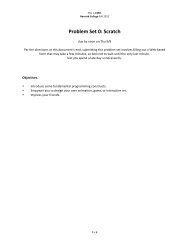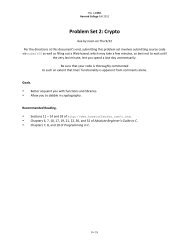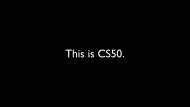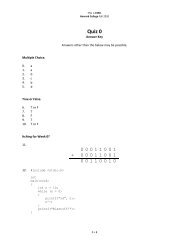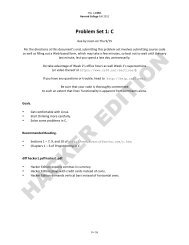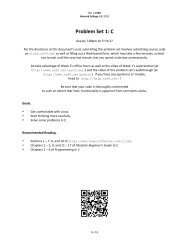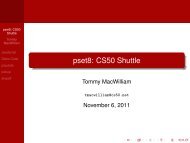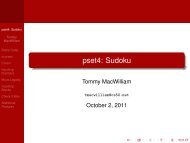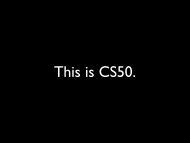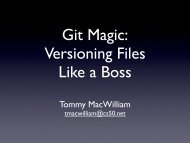Create successful ePaper yourself
Turn your PDF publications into a flip-book with our unique Google optimized e-Paper software.
This is CS50. <br />
Harvard University Fall 2012 <br />
<strong>Problem</strong> <strong>Set</strong> 4: <strong>Forensics</strong> <br />
due by noon on Thu 10/18 <br />
Per the directions at this document's end, submitting this problem set involves submitting source code <br />
via submit50 as well as filling out a Web-‐based form, which may take a few minutes, so best not to <br />
wait until the very last minute, lest you spend a late day unnecessarily. <br />
Goals. <br />
• <br />
• <br />
• <br />
• <br />
Acquaint you with file I/O. <br />
Get you more comfortable with data structures, hexadecimal, and pointers. <br />
Introduce you to computer scientists across campus. <br />
Help Mr. Boddy. <br />
Recommended Reading. 1<br />
• <br />
• <br />
• <br />
• <br />
• <br />
• <br />
http://www.cprogramming.com/tutorial/cfileio.html <br />
Chapters 18, 24, 25, 27, and 28 of Absolute Beginner's Guide to C <br />
Chapters 9, 11, 14, and 16 of Programming in C <br />
http://en.wikipedia.org/wiki/BMP_file_format <br />
http://en.wikipedia.org/wiki/Hexadecimal <br />
http://en.wikipedia.org/wiki/Jpg <br />
1 The Wikipedia articles are a bit dense; feel free to skim or skip! <br />
0 < 21
This is CS50. <br />
Harvard University Fall 2012 <br />
Academic Honesty. <br />
All work that you do toward fulfillment of this course's expectations must be your own unless <br />
collaboration is explicitly allowed in writing by the course's instructor. Collaboration in the completion <br />
of problem sets is not permitted unless otherwise stated by some problem set's specification. <br />
Viewing or copying another individual's work (even if left by a printer, stored in an executable directory, <br />
or posted online) or lifting material from a book, website, or other source—even in part—and <br />
presenting it as your own constitutes academic dishonesty, as does showing or giving your work, even in <br />
part, to another student or soliciting the work of another individual. Similarly is dual submission <br />
academic dishonesty: you may not submit the same or similar work to this course that you have <br />
submitted or will submit to another. Nor may you provide or make available solutions to problem sets <br />
to individuals who take or may take this course in the future. Moreover, submission of any work that <br />
you intend to use outside of the course (e.g., for a job) must be approved by the course's instructor or <br />
preceptor. <br />
You are welcome to discuss the course's material with others in order to better understand it. You may <br />
even discuss problem sets with classmates, but you may not share code. In other words, you may <br />
communicate with classmates in English, but you may not communicate in, say, C. If in doubt as to the <br />
appropriateness of some discussion, contact the course's instructor or preceptor. <br />
You may turn to the Web for instruction beyond the course's lectures and sections, for references, and <br />
for solutions to technical difficulties, but not for outright solutions to problems on problem sets or your <br />
own final project. However, failure to cite (as with comments) the origin of any code or technique that <br />
you do discover outside of the course's lectures and sections (even while respecting these constraints) <br />
and then integrate into your own work may be considered academic dishonesty. <br />
All forms of academic dishonesty are dealt with harshly. If the course refers some matter to the <br />
Administrative Board and the outcome for some student is Admonish, Probation, Requirement to <br />
Withdraw, or Recommendation to Dismiss, the course reserves the right to impose local sanctions on <br />
top of that outcome for that student that may include, but not be limited to, a failing grade for work <br />
submitted or for the course itself. <br />
Fine Print. <br />
Your work on this problem set will be evaluated along four axes primarily. <br />
Scope. To what extent does your code implement the features required by our specification? <br />
Correctness. To what extent is your code consistent with our specifications and free of bugs? <br />
Design. To what extent is your code written well (i.e., clearly, efficiently, elegantly, and/or logically)? <br />
Style. To what extent is your code readable (i.e., commented and indented with variables aptly named)? <br />
All students, whether taking the course Pass/Fail or for a letter grade, must ordinarily submit this and all <br />
other problem sets to be eligible for a passing grade (i.e., Pass or A to D–) unless granted an exception in <br />
writing by the course's instructor or preceptor. No more than one late day may be spent on this, or any <br />
other, problem set. <br />
1 < 21
This is CS50. <br />
Harvard University Fall 2012 <br />
A Section of Questions. <br />
You're welcome to dive into these questions on your own, but know that they'll also be explored in <br />
section! Instead of using CS50 Run or CS50 Spaces for these questions, you'll need to use the CS50 <br />
Appliance. <br />
£ <br />
Head to <br />
https://www.cs50.net/shorts/<br />
and watch the short on valgrind. Be prepared to answer the following question! <br />
£ <br />
£ <br />
What does valgrind do? <br />
How do you use valgrind? <br />
£ <br />
Head to <br />
https://www.cs50.net/shorts/<br />
and watch the short on Redirecting & Pipes. Be prepared to answer the following questions! <br />
£ <br />
£ <br />
£ <br />
To which "stream" do functions like printf write by default? <br />
What's the difference between > and >>? <br />
What pipeline could you use to find the number of unique names in a file called names.txt? <br />
£ <br />
£ <br />
You may also want to re-‐watch the short on GDB! <br />
This section of questions comes with some distribution code that you'll need to download before <br />
getting started. Go ahead and execute <br />
cd ~/Dropbox<br />
in order to navigate to your ~/Dropbox directory. Then execute <br />
wget http://cdn.cs50.net/2012/fall/sections/5/section5.zip<br />
in order to download a ZIP (i.e., compressed version) of this section's distro. If you then execute <br />
ls<br />
you should see that you now have a file called section5.zip in your ~/Dropbox directory. <br />
Unzip it by executing the below. <br />
unzip section5.zip<br />
If you again execute <br />
ls<br />
2 < 21
This is CS50. <br />
Harvard University Fall 2012 <br />
you should see that you now also have a section5 directory. You're now welcome to delete the <br />
ZIP file with the below. <br />
rm -f section5.zip<br />
Now dive into that section5 directory by executing the below. <br />
cd section5<br />
Now execute <br />
ls<br />
and you should see that the directory contains the below. <br />
buggy1 buggy2 buggy3 buggy4 cat.c<br />
buggy1.c buggy2.c buggy3.c buggy4.c cp.c<br />
Whereas most of those are source files, buggy1, buggy2, buggy3, and buggy4 are binary files <br />
that we've compiled for you. Indeed, if you try opening the files with gedit, you'll see a bunch of <br />
binary gobbledygook. <br />
£ <br />
By now, you should know what gdb is, even though you might not fully appreciate it or <br />
understand it. Time to fix! <br />
As those programs' filenames suggest, they're a bit buggy, so your mission is to figure out why <br />
using gdb! Go ahead and execute the below. <br />
./buggy1<br />
What happens? How about buggy2, buggy3, and buggy4? 2<br />
buggy1. Go ahead and execute the below. <br />
Hm, not so good. Let's try to debug <br />
gdb ./buggy1 <br />
Next, set a breakpoint at the start of main by executing <br />
break main<br />
at gdb's prompt. And then execute <br />
run<br />
at gdb's prompt to get buggy1 running. From there, see if you can figure out why buggy1 is so <br />
buggy. Odds are you'll find the following commands helpful: r(un), n(ext), p(rint), q(uit), <br />
h(elp), bt (backtrace), b(reak), u(p), d(own), and l(ist). <br />
2 Recall that you can force a program to quit with ctrl-‐c. <br />
3 < 21
This is CS50. <br />
Harvard University Fall 2012 <br />
Once you've figured out the source of buggy1's woes, move on to buggy2, buggy3, and buggy4! <br />
Consider these buggy programs an opportunity to practice with gdb. No need to fix any bugs; the <br />
goal is simply to identify them. You won't be asked to submit anything for these programs. <br />
£<br />
Toward the end of Redirecting & Pipes, Tommy introduces cat, which concatenates files' contents <br />
and prints them to standard output (otherwise known as stdout). Now's your chance to <br />
implement your own version of cat! <br />
Open up cat.c with gedit and take a look around. Keep in mind that there are (at least) four <br />
things that you can do with files: open them, close them, read from them, and write to them. <br />
Now, you need to open a file before you can read from it or write to it, much like you have to <br />
open up your C code in a text editor like gedit before you can edit it! However, unlike a text <br />
editor, when you open a file you have to specify what you want to do to it: read it, blow away its <br />
contents and write new stuff to it, or keep its contents and append new stuff to it. Read mode is <br />
specified with "r", write mode is indicated by "w", and unsurprisingly, append mode is denoted <br />
by "a". <br />
Notice, now, that cat.c describes its usage as follows: <br />
Usage: cat filename [filename ...]<br />
In general, square brackets in this context indicate that the second filename is optional but could <br />
even be followed by more filenames, as implied by the ellipsis. <br />
The challenge at hand is to complete this implementation of cat! Per its usage, you'll want to <br />
open each file whose name is specified in argv, read into memory its characters, and print those <br />
characters to stdout. Odds are you'll find fgetc of interest, but note that it returns an int, not <br />
a char. There's another function called fread that you could use, but using it is a bit more <br />
involved. For printing to stdout, putc, fwrite, and printf are all possible options! <br />
To test whether your program is working, try creating a file (say, foo.txt) with gedit that has <br />
just a few characters, letters, and/or lines and then try running your version cat, as with the <br />
below, to see if it spits out everything you expect! <br />
./cat foo.txt<br />
You can also try out the version of cat that comes with Linux itself, and then compare its output <br />
against yours, as by running the below. <br />
cat foo.txt<br />
Of course, be sure to test your version of cat with multiple filenames in argv at once as well! <br />
Consider this problem an opportunity to practice; you won't be asked to submit this program. <br />
4 < 21
This is CS50. <br />
Harvard University Fall 2012 <br />
£ <br />
Now that you're a master of reading files, let's add some writing into the mix. By now, you've <br />
probably had to copy a file or two using the cp command. It turns out that it's not that much <br />
more difficult to write now that you've implemented cat. <br />
Go ahead and complete the implementation of cp.c, per the usage instructions therein, where <br />
source is the name of the file to be copied, and destination is the filename (or path) for the <br />
copy. <br />
As with cat, you'll probably find fgetc (or fread) quite handy for reading! For writing, however, <br />
you'll now want to use fputc instead of putc, though fwrite will still work if using fread. <br />
Thoughts on how best to test your implementation? <br />
Consider this problem an opportunity to practice; you won't be asked to submit this program. <br />
Getting Started. <br />
R <br />
£ <br />
Welcome back! <br />
Start up your appliance and, upon reaching John Harvard's desktop, open a terminal window <br />
(remember how?) and execute <br />
update50<br />
to ensure that your appliance is up-‐to-‐date! <br />
£ <br />
Like <strong>Problem</strong> <strong>Set</strong> 3, this problem set comes with some distribution code that you'll need to <br />
download before getting started. Go ahead and execute <br />
cd ~/Dropbox<br />
in order to navigate to your ~/Dropbox directory. Then execute <br />
wget http://cdn.cs50.net/2012/fall/psets/4/pset4.zip<br />
in order to download a ZIP (i.e., compressed version) of this problem set's distro. If you then <br />
execute <br />
ls<br />
you should see that you now have a file called pset4.zip in your ~/Dropbox directory. Unzip it <br />
by executing the below. <br />
unzip pset4.zip<br />
5 < 21
This is CS50. <br />
Harvard University Fall 2012 <br />
If you again execute <br />
ls<br />
you should see that you now also have a pset4 directory. You're now welcome to delete the ZIP <br />
file with the below. <br />
rm -f pset4.zip<br />
Now dive into that pset4 directory by executing the below. <br />
cd pset4<br />
Now execute <br />
ls<br />
and you should see that the directory contains the below. <br />
bmp/ jpg/ questions.txt<br />
How fun! Two subdirectories and a file. Who knows what could be inside! Let's get started. <br />
£ <br />
If you ever saw Windows XP's default wallpaper (think rolling hills and blue skies), then you've <br />
seen a BMP. If you've ever looked at a webpage, you've probably seen a GIF. If you've ever <br />
looked at a digital photo, you've probably seen a JPEG. If you've ever taken a screenshot on a <br />
Mac, you've probably seen a PNG. Read up a bit on the BMP, GIF, JPEG, and PNG file formats. 3<br />
Then, open up questions.txt in ~/Dropbox/pset4, as with gedit, and tell us the below. <br />
0. How many different colors does each format support? <br />
1. Which of these formats supports animation? <br />
2. What's the difference between lossy and lossless compression? <br />
3. Which of these formats is lossy-‐compressed? <br />
£ <br />
Curl up with the article from MIT below. <br />
http://cdn.cs50.net/2012/fall/psets/4/garfinkel.pdf<br />
Though somewhat technical, you should find the article's language quite accessible. Once you've <br />
read the article, answer each of the following questions in a sentence or more in <br />
~/Dropbox/pset4/questions.txt. <br />
4. What happens, technically speaking, when a file is deleted on a FAT file system? <br />
5. What can someone like you do to ensure (with high probability) that files you delete cannot <br />
be recovered? <br />
3 For this question, you're welcome to consult How Computers Work, Google, Wikipedia, a friend, or anyone else, so long as <br />
your words are ultimately your own! <br />
6 < 21
This is CS50. <br />
Harvard University Fall 2012 <br />
Whodunit. <br />
£ <br />
Welcome to Tudor Mansion. Your host, Mr. John Boddy, has met an untimely end—he's the <br />
victim of foul play. To win this game, you must determine whodunit. <br />
Unfortunately for you (though even more unfortunately for Mr. Boddy), the only evidence you <br />
have is a 24-‐bit BMP file called clue.bmp, pictured below, that Mr. Boddy whipped up on his <br />
computer in his final moments. 4 Hidden among this file's red "noise" is a drawing of whodunit. <br />
You long ago threw away that piece of red plastic from childhood that would solve this mystery for <br />
you, and so you must attack it as a computer scientist instead. <br />
But, first, some background. <br />
4 Realize that this BMP is in color even though you might have printed this document in black and white. <br />
7 < 21
This is CS50. <br />
Harvard University Fall 2012 <br />
£ <br />
Perhaps the simplest way to represent an image is with a grid of pixels (i.e., dots), each of which <br />
can be of a different color. For black-‐and-‐white images, we thus need 1 bit per pixel, as 0 could <br />
represent black and 1 could represent white, as in the below. 5<br />
In this sense, then, is an image just a bitmap (i.e., a map of bits). For more colorful images, you <br />
simply need more bits per pixel. A file format (like GIF) that supports "8-‐bit color" uses 8 bits per <br />
pixel. A file format (like BMP, JPEG, or PNG) that supports "24-‐bit color" uses 24 bits per pixel. 6<br />
A 24-‐bit BMP like Mr. Boddy's uses 8 bits to signify the amount of red in a pixel's color, <br />
8 bits to signify the amount of green in a pixel's color, and 8 bits to signify the amount of blue in a <br />
pixel's color. If you've ever heard of RGB color, well, there you have it: red, green, blue. <br />
If the R, G, and B values of some pixel in a BMP are, say, 0xff, 0x00, and 0x00 in hexadecimal, that <br />
pixel is purely red, as 0xff (otherwise known as 255 in decimal) implies "a lot of red," while 0x00 <br />
and 0x00 imply "no green" and "no blue," respectively. Given how red Mr. Boddy's BMP is, it <br />
clearly has a lot of pixels with those RGB values. But it also has a few with other values. <br />
Incidentally, HTML and CSS (languages in which webpages can be written) model colors in this <br />
same way. If curious, see the URL below for more details. <br />
http://en.wikipedia.org/wiki/Web_colors<br />
Now let's get more technical. Recall that a file is just a sequence of bits, arranged in some fashion. <br />
A 24-‐bit BMP file, then, is essentially just a sequence of bits, (almost) every 24 of which happen to <br />
represent some pixel's color. But a BMP file also contains some "metadata," information like an <br />
image's height and width. That metadata is stored at the beginning of the file in the form of two <br />
data structures generally referred to as "headers" (not to be confused with C's header files). 7 The <br />
first of these headers, called BITMAPFILEHEADER, is 14 bytes long. (Recall that 1 byte equals <br />
8 bits.) The second of these headers, called BITMAPINFOHEADER, is 40 bytes long. Immediately <br />
following these headers is the actual bitmap: an array of bytes, triples of which represent a pixel's <br />
color. 8 However, BMP stores these triples backwards (i.e., as BGR), with 8 bits for blue, followed <br />
5 Image adapted from http://www.brackeen.com/vga/bitmaps.html. <br />
6 BMP actually supports 1-‐, 4-‐, 8-‐, 16-‐, 24-‐, and 32-‐bit color. <br />
7 Incidentally, these headers have evolved over time. This problem set only expects that you support version 4.0 (the latest) of <br />
Microsoft's BMP format, which debuted with Windows 95. <br />
8 In 1-‐, 4-‐, and 16-‐bit BMPs (but not 24-‐ or 32-‐), there's an additional header right after BITMAPINFOHEADER called <br />
RGBQUAD, an array that defines "intensity values" for each of the colors in a device's palette. <br />
8 < 21
This is CS50. <br />
Harvard University Fall 2012 <br />
by 8 bits for green, followed by 8 bits for red. 9 In other words, were we to convert the 1-‐bit smiley <br />
above to a 24-‐bit smiley, substituting red for black, a 24-‐bit BMP would store this bitmap as <br />
follows, where 0000ff signifies red and ffffff signifies white; we've highlighted in red all <br />
instances of 0000ff. <br />
ffffff ffffff 0000ff 0000ff 0000ff 0000ff ffffff ffffff<br />
ffffff 0000ff ffffff ffffff ffffff ffffff 0000ff ffffff<br />
0000ff ffffff 0000ff ffffff ffffff 0000ff ffffff 0000ff<br />
0000ff ffffff ffffff ffffff ffffff ffffff ffffff 0000ff<br />
0000ff ffffff 0000ff ffffff ffffff 0000ff ffffff 0000ff<br />
0000ff ffffff ffffff 0000ff 0000ff ffffff ffffff 0000ff<br />
ffffff 0000ff ffffff ffffff ffffff ffffff 0000ff ffffff<br />
ffffff ffffff 0000ff 0000ff 0000ff 0000ff ffffff ffffff<br />
Because we've presented these bits from left to right, top to bottom, in 8 columns, you can <br />
actually see the red smiley if you take a step back. <br />
To be clear, recall that a hexadecimal digit represents 4 bits. Accordingly, ffffff in hexadecimal <br />
actually signifies 111111111111111111111111 in binary. <br />
Okay, stop! Don't proceed further until you're sure you understand why 0000ff represents a red <br />
pixel in a 24-‐bit BMP file. <br />
£ <br />
Okay, let's transition from theory to practice. Double-‐click Home on John Harvard's desktop and <br />
you should find yourself in John Harvard's home directory. Double-‐click pset4, double-‐click bmp, <br />
and then double-‐click smiley.bmp therein. You should see a tiny smiley face that's only 8 pixels by <br />
8 pixels. Select View > Zoom > Zoom Fit, and you should see a larger, albeit blurrier, version. (So <br />
much for "enhance," huh?) Actually, this particular image shouldn't really be blurry, even when <br />
enlarged. The program that launched when you double-‐clicked smiley.bmp (called Ristretto <br />
Image Viewer) is simply trying to be helpful (CSI-‐style) by "dithering" the image (i.e., by smoothing <br />
out its edges). Below's what the smiley looks like if you zoom in without dithering. At this zoom <br />
level, you can really see the image's pixels (as big squares). <br />
9 Some BMPs also store the entire bitmap backwards, with an image's top row at the end of the BMP file. But we've stored this <br />
problem set's BMPs as described herein, with each bitmap's top row first and bottom row last. <br />
9 < 21
This is CS50. <br />
Harvard University Fall 2012 <br />
Okay, go ahead and return your attention to a terminal window, and navigate your way to <br />
~/Dropbox/pset4/bmp. (Remember how?) Let's look at the underlying bytes that compose <br />
smiley.bmp using xxd, a command-‐line "hex editor." Execute: <br />
xxd -c 24 -g 3 -s 54 smiley.bmp<br />
You should see the below; we've again highlighted in red all instances of 0000ff. <br />
0000036: ffffff ffffff 0000ff 0000ff 0000ff 0000ff ffffff ffffff ........................<br />
000004e: ffffff 0000ff ffffff ffffff ffffff ffffff 0000ff ffffff ........................<br />
0000066: 0000ff ffffff 0000ff ffffff ffffff 0000ff ffffff 0000ff ........................<br />
000007e: 0000ff ffffff ffffff ffffff ffffff ffffff ffffff 0000ff ........................<br />
0000096: 0000ff ffffff 0000ff ffffff ffffff 0000ff ffffff 0000ff ........................<br />
00000ae: 0000ff ffffff ffffff 0000ff 0000ff ffffff ffffff 0000ff ........................<br />
00000c6: ffffff 0000ff ffffff ffffff ffffff ffffff 0000ff ffffff ........................<br />
00000de: ffffff ffffff 0000ff 0000ff 0000ff 0000ff ffffff ffffff ........................<br />
In the leftmost column above are addresses within the file or, equivalently, offsets from the file's <br />
first byte, all of them given in hex. Note that 00000036 in hexadecimal is 54 in decimal. You're <br />
thus looking at byte 54 onward of smiley.gif. Recall that a 24-‐bit BMP's first 14 + 40 = 54 bytes <br />
are filled with metadata. If you really want to see that metadata in addition to the bitmap, <br />
execute the command below. <br />
xxd -c 24 -g 3 smiley.bmp<br />
If smiley.bmp actually contained ASCII characters, you'd see them in xxd's rightmost column <br />
instead of all of those dots. <br />
£ <br />
So, smiley.bmp is 8 pixels wide by 8 pixels tall, and it's a 24-‐bit BMP (each of whose <br />
pixels is represented with 24 ÷ 8 = 3 bytes). Each row (aka "scanline") thus takes up <br />
(8 pixels) × (3 bytes per pixel) = 24 bytes, which happens to be a multiple of 4. It turns out that <br />
BMPs are stored a bit differently if the number of bytes in a scanline is not, in fact, a multiple of 4. <br />
In small.bmp, for instance, is another 24-‐bit BMP, a green box that's 3 pixels wide by 3 pixels <br />
wide. If you view it with Ristretto Image Viewer (as by double-‐clicking it), you'll see that it <br />
resembles the below, albeit much smaller. (Indeed, you might need to zoom in again to see it.) <br />
10 < 21
This is CS50. <br />
Harvard University Fall 2012 <br />
Each scanline in small.bmp thus takes up (3 pixels) × (3 bytes per pixel) = 9 bytes, which is not a <br />
multiple of 4. And so the scanline is "padded" with as many zeroes as it takes to extend the <br />
scanline's length to a multiple of 4. In other words, between 0 and 3 bytes of padding are needed <br />
for each scanline in a 24-‐bit BMP. (Understand why?) In the case of small.bmp, 3 bytes' worth <br />
of zeroes are needed, since (3 pixels) × (3 bytes per pixel) + (3 bytes of padding) = 12 bytes, which <br />
is indeed a multiple of 4. <br />
To "see" this padding, go ahead and run the below. <br />
xxd -c 12 -g 3 -s 54 small.bmp<br />
Note that we're using a different value for -c than we did for smiley.bmp so that xxd outputs <br />
only 4 columns this time (3 for the green box and 1 for the padding). You should see output like <br />
the below; we've highlighted in green all instances of 00ff00. <br />
0000036: 00ff00 00ff00 00ff00 000000 ............<br />
0000042: 00ff00 ffffff 00ff00 000000 ............<br />
000004e: 00ff00 00ff00 00ff00 000000 ............<br />
For contrast, let's use xxd on large.bmp, which looks identical to small.bmp but, at 12 pixels <br />
by 12 pixels, is four times as large. Go ahead and execute the below; you may need to widen your <br />
window to avoid wrapping. <br />
xxd -c 36 -g 3 -s 54 large.bmp<br />
You should see output like the below; we've again highlighted in green all instances of 00ff00 <br />
0000036: 00ff00 00ff00 00ff00 00ff00 00ff00 00ff00 00ff00 00ff00 00ff00 00ff00 00ff00 00ff00 ....................................<br />
000005a: 00ff00 00ff00 00ff00 00ff00 00ff00 00ff00 00ff00 00ff00 00ff00 00ff00 00ff00 00ff00 ....................................<br />
000007e: 00ff00 00ff00 00ff00 00ff00 00ff00 00ff00 00ff00 00ff00 00ff00 00ff00 00ff00 00ff00 ....................................<br />
00000a2: 00ff00 00ff00 00ff00 00ff00 00ff00 00ff00 00ff00 00ff00 00ff00 00ff00 00ff00 00ff00 ....................................<br />
00000c6: 00ff00 00ff00 00ff00 00ff00 ffffff ffffff ffffff ffffff 00ff00 00ff00 00ff00 00ff00 ....................................<br />
00000ea: 00ff00 00ff00 00ff00 00ff00 ffffff ffffff ffffff ffffff 00ff00 00ff00 00ff00 00ff00 ....................................<br />
000010e: 00ff00 00ff00 00ff00 00ff00 ffffff ffffff ffffff ffffff 00ff00 00ff00 00ff00 00ff00 ....................................<br />
0000132: 00ff00 00ff00 00ff00 00ff00 ffffff ffffff ffffff ffffff 00ff00 00ff00 00ff00 00ff00 ....................................<br />
0000156: 00ff00 00ff00 00ff00 00ff00 00ff00 00ff00 00ff00 00ff00 00ff00 00ff00 00ff00 00ff00 ....................................<br />
000017a: 00ff00 00ff00 00ff00 00ff00 00ff00 00ff00 00ff00 00ff00 00ff00 00ff00 00ff00 00ff00 ....................................<br />
000019e: 00ff00 00ff00 00ff00 00ff00 00ff00 00ff00 00ff00 00ff00 00ff00 00ff00 00ff00 00ff00 ....................................<br />
00001c2: 00ff00 00ff00 00ff00 00ff00 00ff00 00ff00 00ff00 00ff00 00ff00 00ff00 00ff00 00ff00 ....................................<br />
Worthy of note is that this BMP lacks padding! After all, (12 pixels) × (3 bytes per pixel) = 36 bytes <br />
is indeed a multiple of 4. <br />
Knowing all this has got to be useful! <br />
£ Okay, xxd only showed you the bytes in these BMPs. How do we actually get at them <br />
programmatically? Well, in copy.c is a program whose sole purpose in life is to create a copy of a <br />
BMP, piece by piece. Of course, you could just use cp for that. But cp isn't going to help Mr. <br />
Boddy. Let's hope that copy.c does! <br />
11 < 21
This is CS50. <br />
Harvard University Fall 2012 <br />
Go ahead and compile copy.c into a program called copy using make. (Remember how?) Then <br />
execute a command like the below. <br />
./copy smiley.bmp copy.bmp<br />
If you then execute ls (with the appropriate switch), you should see that smiley.bmp and <br />
copy.bmp are indeed the same size. Let's double-‐check that they're actually the same! Execute <br />
the below. <br />
diff smiley.bmp copy.bmp<br />
If that command tells you nothing, the files are indeed identical. 10 Feel free to open both files in <br />
Ristretto Image Viewer (as by double-‐clicking each) to confirm as much visually. But diff does a <br />
byte-‐by-‐byte comparison, so its eye is probably sharper than yours! <br />
So how now did that copy get made? It turns out that copy.c relies on bmp.h. Let's take a look. <br />
Open up bmp.h (as with gedit), and you'll see actual definitions of those headers we've <br />
mentioned, adapted from Microsoft's own implementations thereof. In addition, that file defines <br />
BYTE, DWORD, LONG, and WORD, data types normally found in the world of Win32 (i.e., Windows) <br />
programming. Notice how they're just aliases for primitives with which you are (hopefully) <br />
already familiar. It appears that BITMAPFILEHEADER and BITMAPINFOHEADER make use of <br />
these types. This file also defines a struct called RGBTRIPLE that, quite simply, "encapsulates" <br />
three bytes: one blue, one green, and one red (the order, recall, in which we expect to find RGB <br />
triples actually on disk). <br />
Why are these structs useful? Well, recall that a file is just a sequence of bytes (or, ultimately, <br />
bits) on disk. But those bytes are generally ordered in such a way that the first few represent <br />
something, the next few represent something else, and so on. "File formats" exist because the <br />
world has standardized what bytes mean what. Now, we could just read a file from disk into RAM <br />
as one big array of bytes. And we could just remember that the byte at location [i] represents <br />
one thing, while the byte at location [j] represents another. But why not give some of those <br />
bytes names so that we can retrieve them from memory more easily? That's precisely what the <br />
structs in bmp.h allow us to do. Rather than think of some file as one long sequence of bytes, <br />
we can instead think of it as a sequence of structs. <br />
10 Note that some programs (e.g., Photoshop) include trailing zeroes at the ends of some BMPs. Our version of copy throws <br />
those away, so don't be too worried if you try to copy a BMP (that you've downloaded or made) only to find that the copy is <br />
actually a few bytes smaller than the original. <br />
12 < 21
This is CS50. <br />
Harvard University Fall 2012 <br />
Recall that smiley.bmp is 8 by 8 pixels, and so it should take up 14 + 40 + 8 ·∙ 8 ·∙ 3 = 246 bytes on <br />
disk. (Confirm as much if you'd like using ls.) Here's what it thus looks like on disk according to <br />
Microsoft: <br />
offset type name<br />
0 WORD bfType<br />
2 DWORD bfSize<br />
6 WORD bfReserved1<br />
8 WORD bfReserved2<br />
10 DWORD bfOffBits<br />
14 DWORD biSize<br />
18 LONG biWidth<br />
22 LONG biHeight<br />
26 WORD biPlanes<br />
28 WORD biBitCount<br />
30 DWORD biCompression<br />
34 DWORD biSizeImage<br />
38 LONG biXPelsPerMeter<br />
42 LONG biYPelsPerMeter<br />
46 DWORD biClrUsed<br />
50 DWORD biClrImportant<br />
54 BYTE rgbtBlue<br />
55 BYTE rgbtGreen<br />
56 BYTE rgbtRed<br />
57 BYTE rgbtBlue<br />
58 BYTE rgbtGreen<br />
59 BYTE rgbtRed<br />
...<br />
243 BYTE rgbtBlue<br />
244 BYTE rgbtGreen<br />
245 BYTE rgbtRed<br />
BITMAPFILEHEADER<br />
BITMAPINFOHEADER<br />
RGBTRIPLE<br />
RGBTRIPLE<br />
RGBTRIPLE<br />
As this figure suggests, order does matter when it comes to structs' members. Byte 57 is <br />
rgbtBlue (and not, say, rgbtRed), because rgbtBlue is defined first in RGBTRIPLE. 11<br />
Now go ahead and pull up the URLs to which BITMAPFILEHEADER and BITMAPINFOHEADER are <br />
attributed, per the comments in bmp.h. You're about to start using MSDN (Microsoft Developer <br />
Network)! <br />
Rather than hold your hand further on a stroll through copy.c, we're instead going to ask you <br />
some questions and let you teach yourself how the code therein works. As always, man is your <br />
friend, and so, now, is MSDN. If not sure on first glance how to answer some question, do some <br />
quick research and figure it out! You might want to turn to the below resource as well. <br />
http://www.cs50.net/resources/cppreference.com/stdio/ <br />
11 Our use, incidentally, of the __attribute__ called __packed__ ensures that gcc does not try to "word-‐align" members <br />
(whereby the address of each member's first byte is a multiple of 4), lest we end up with "gaps" in our structs that don't <br />
actually exist on disk. <br />
13 < 21
This is CS50. <br />
Harvard University Fall 2012 <br />
Allow us to suggest that you also run copy within gdb while answering these questions. <strong>Set</strong> a <br />
breakpoint at main and walk through the program. Recall that you can tell gdb to start running <br />
the program with a command like the below at gdb's prompt. <br />
run smiley.bmp copy.bmp<br />
If you tell gdb to print the values of bf and bi (once read in from disk), you'll see output like the <br />
below, which we daresay you'll find quite useful. <br />
{bfType = 19778, bfSize = 246, bfReserved1 = 0, bfReserved2 = 0,<br />
bfOffBits = 54}<br />
{biSize = 40, biWidth = 8, biHeight = -8, biPlanes = 1, biBitCount = 24,<br />
biCompression = 0, biSizeImage = 192, biXPelsPerMeter = 2834,<br />
biYPelsPerMeter = 2834, biClrUsed = 0, biClrImportant = 0}<br />
In ~/Dropbox/pset4/questions.txt, answer each of the following questions in a sentence or <br />
more. <br />
6. What's stdint.h? <br />
7. What's the point of using uint8_t, uint32_t, int32_t, and uint16_t in a program? <br />
8. How many bytes is a BYTE, a DWORD, a LONG, and a WORD, respectively? 12<br />
9. What (in ASCII, decimal, or hexadecimal) must the first two bytes of any BMP file be? 13<br />
10. What's the difference between bfSize and biSize? <br />
11. What does it mean if biHeight is negative? <br />
12. What field in BITMAPINFOHEADER specifies the BMP's color depth (i.e., bits per pixel)? <br />
13. Why might fopen return NULL in copy.c:37? <br />
14. Why is the third argument to fread always 1 in our code? <br />
15. What value does copy.c:70 assign padding if bi.biWidth is 3? <br />
16. What does fseek do? <br />
17. What is SEEK_CUR? <br />
Okay, back to Mr. Boddy. <br />
£ <br />
Write a program called whodunit in a file called whodunit.c that reveals Mr. Boddy's drawing. <br />
Ummm, what? <br />
12 Assume a 32-‐bit architecture like the CS50 Appliance. <br />
13 Leading bytes used to identify file formats (with high probability) are generally called "magic numbers." <br />
14 < 21
This is CS50. <br />
Harvard University Fall 2012 <br />
Well, think back to childhood when you held that piece of red plastic over similarly hidden <br />
messages. 14 Essentially, the plastic turned everything red but somehow revealed those messages. <br />
Implement that same idea in whodunit. Like copy, your program should accept exactly two <br />
command-‐line arguments. And if you execute a command like the below, stored in verdict.bmp <br />
should be a BMP in which Mr. Boddy's drawing is no longer covered with noise. <br />
whodunit clue.bmp verdict.bmp<br />
Allow us to suggest that you begin tackling this mystery by executing the command below. <br />
cp copy.c whodunit.c<br />
Wink wink. You may be amazed by how few lines of code you actually need to write in order to <br />
help Mr. Boddy. <br />
There's nothing hidden in smiley.bmp, but feel free to test your program out on its pixels <br />
nonetheless, if only because that BMP is small and you can thus compare it and your own <br />
program's output with xxd during development. 15<br />
Rest assured that more than one solution is possible. So long as Mr. Boddy's drawing is <br />
identifiable (by your teaching fellow), no matter its color(s), Mr. Boddy will rest in peace. <br />
£ <br />
In ~/Dropbox/pset4/questions.txt, answer the question below. <br />
18. Whodunit? <br />
£ <br />
Well that was fun. Bit late for Mr. Boddy, though. <br />
Alright, next challenge! Implement now in resize.c a program called resize that resizes 24-‐bit <br />
uncompressed BMPs by a factor of n. Your program should accept exactly three command-‐line <br />
arguments, per the below usage, whereby the first (n) must be a positive integer less than or <br />
equal to 100, the second the name of the file to be resized, and the third the name of the resized <br />
version to be written. <br />
Usage: resize n infile outfile<br />
With a program like this, we could have created large.bmp out of small.bmp by resizing the <br />
latter by a factor of 4 (i.e., by multiplying both its width and it s height by 4), per the below. 16<br />
./resize 4 small.bmp large.bmp<br />
You're welcome to get started by copying (yet again) copy.c and naming the copy resize.c. <br />
But spend some time thinking about what it means to resize a BMP. 17 Decide which of the fields in <br />
14 If you remember no such piece of plastic, best to ask a friend or TF about his or her childhood. <br />
15 Or maybe there is a message hidden in smiley.bmp too. No, there's not. <br />
16 And yet we used Photoshop. <br />
17 You may assume that n times the size of infile will not exceed 2 32 – 1. <br />
15 < 21
This is CS50. <br />
Harvard University Fall 2012 <br />
BITMAPFILEHEADER and BITMAPINFOHEADER you might need to modify. Consider whether or <br />
not you'll need to add or subtract padding to scanlines. And be thankful that we don't expect you <br />
to support fractional n between 0 and 1! 18,19<br />
If you'd like to play with the staff's own implementation of resize in the appliance, you may <br />
execute the below. 20<br />
~cs50/pset4/resize<br />
£ <br />
Best to run <br />
submit50 ~/Dropbox/pset4<br />
from time to time in order to back up your code to CS50's servers. (Your TF will grade your final <br />
submission.) <br />
CSI. 21<br />
£ <br />
Alright, now let's put all your new skills to the test. <br />
In anticipation of this problem set, I spent the past several days snapping photos of people I know, <br />
all of which were saved by my digital camera as JPEGs on a 1GB CompactFlash (CF) card. 22<br />
Unfortunately, I'm not very good with computers, and I somehow deleted them all! Thankfully, in <br />
the computer world, "deleted" tends not to mean "deleted" so much as "forgotten." My <br />
computer insists that the CF card is now blank, but I'm pretty sure it's lying to me. <br />
Write a program in ~/Dropbox/pset4/jpg/ called recover that recovers these photos. <br />
Ummm. <br />
Okay, here's the thing. Even though JPEGs are more complicated than BMPs, JPEGs have <br />
"signatures," patterns of bytes that distinguish them from other file formats. In fact, most JPEGs <br />
begin with one of two sequences of bytes. Specifically, the first four bytes of most JPEGs are <br />
either <br />
0xff 0xd8 0xff 0xe0<br />
or <br />
0xff 0xd8 0xff 0xe1<br />
18 As we do in the Hacker Edition! <br />
19 But we do expect you to support n = 1, the result of which should be an outfile with dimensions identical to infile's. <br />
20 We've not made solutions available for this problem set's other programs, lest they spoil the forensic fun. <br />
21 Computer Science Investigation <br />
22 It's possible I actually spent the past several days on Facebook instead. <br />
16 < 21
This is CS50. <br />
Harvard University Fall 2012 <br />
from first byte to fourth byte, left to right. Odds are, if you find one of these patterns of bytes on <br />
a disk known to store photos (e.g., my CF card), they demark the start of a JPEG. 23<br />
Fortunately, digital cameras tend to store photographs contiguously on CF cards, whereby each <br />
photo is stored immediately after the previously taken photo. Accordingly, the start of a JPEG <br />
usually demarks the end of another. However, digital cameras generally initialize CF cards with a <br />
FAT file system whose "block size" is 512 bytes (B). The implication is that these cameras only <br />
write to those cards in units of 512 B. A photo that's 1 MB (i.e., 1,048,576 B) thus takes up <br />
1048576 ÷ 512 = 2048 "blocks" on a CF card. But so does a photo that's, say, one byte smaller <br />
(i.e., 1,048,575 B)! The wasted space on disk is called "slack space." Forensic investigators often <br />
look at slack space for remnants of suspicious data. <br />
The implication of all these details is that you, the investigator, can probably write a program that <br />
iterates over a copy of my CF card, looking for JPEGs' signatures. Each time you find a signature, <br />
you can open a new file for writing and start filling that file with bytes from my CF card, closing <br />
that file only once you encounter another signature. Moreover, rather than read my CF card's <br />
bytes one at a time, you can read 512 of them at a time into a buffer for efficiency's sake. Thanks <br />
to FAT, you can trust that JPEGs' signatures will be "block-‐aligned." That is, you need only look for <br />
those signatures in a block's first four bytes. <br />
Realize, of course, that JPEGs can span contiguous blocks. Otherwise, no JPEG could be larger <br />
than 512 B. But the last byte of a JPEG might not fall at the very end of a block. Recall the <br />
possibility of slack space. But not to worry. Because this CF card was brand-‐new when I started <br />
snapping photos, odds are it'd been "zeroed" (i.e., filled with 0s) by the manufacturer, in which <br />
case any slack space will be filled with 0s. It's okay if those trailing 0s end up in the JPEGs you <br />
recover; they should still be viewable. <br />
Now, I only have one CF card, but there are a whole lot of you! And so I've gone ahead and <br />
created a "forensic image" of the card, storing its contents, byte after byte, in a file called <br />
card.raw. So that you don't waste time iterating over millions of 0s unnecessarily, I've only <br />
imaged the first few megabytes of the CF card. But you should ultimately find that the image <br />
contains 51 JPEGs. As usual, you can open the file programmatically with fopen, as in the <br />
below. 24<br />
FILE* fp = fopen("card.raw", "r");<br />
Notice, incidentally, that ~/Dropbox/pset4/jpg/ contains only recover.c, but it's devoid of <br />
any code. (We leave it to you to decide how to implement and compile recover!) For simplicity, <br />
you may hard-‐code "card.raw" in your program; your program need not accept any command-line<br />
arguments. When executed, though, your program should recover every one of the JPEGs <br />
from card.raw, storing each as a separate file in your current working directory. Your program <br />
should number the files it outputs by naming each ###.jpg, where ### is three-‐digit decimal <br />
number from 000 on up. (Befriend sprintf.) You need not try to recover the JPEGs' original <br />
23 To be sure, you might encounter these patterns on some disk purely by chance, so data recovery isn't an exact science. <br />
24 It's fine to hard-‐code this path into your program rather than define it as some constant. <br />
17 < 21
This is CS50. <br />
Harvard University Fall 2012 <br />
names. To check whether the JPEGs your program spit out are correct, simply double-‐click and <br />
take a look! If each photo appears intact, your operation was likely a success! <br />
Odds are, though, the JPEGs that the first draft of your code spits out won't be correct. (If you <br />
open them up and don't see anything, they're probably not correct!) Execute the command below <br />
to delete all JPEGs in your current working directory. <br />
rm *.jpg<br />
If you'd rather not be prompted to confirm each deletion, execute the command below instead. <br />
rm -f *.jpg<br />
Just be careful with that -f switch, as it "forces" deletion. <br />
£ <br />
Don't forget to run <br />
submit50 ~/pset4<br />
from time to time in order to back up your code to CS50's servers! <br />
I Saw You Harvard. <br />
£ <br />
And now the real fun begins. You and your section are hereby challenged to find as many of the <br />
computer scientists featured in these photos as possible. To prove that you found someone, take <br />
a photo of yourself (or of someone in your section) posing with the computer scientist. Upload <br />
your section's photos (i.e., the photos you took, not the ones that you recovered) to an album <br />
somewhere (e.g., Facebook, Flickr, Picasa Web Albums, etc.); just be sure your TF can access the <br />
album. 25 Then have your TF email your album's URL to heads@cs50.net by noon on Wed 10/31! <br />
The section that identifies and photographs the most computer scientists shall win a fabulous <br />
prize. In the event of a tie, the section that submitted first shall be decreed the winner. <br />
25 You should probably nominate someone(s) in your section to take charge. <br />
18 < 21
This is CS50. <br />
Harvard University Fall 2012 <br />
Sanity Checks. <br />
Before you consider this problem set done, best to ask yourself these questions and then go back and <br />
improve your code as needed! Do not consider the below an exhaustive list of expectations, though, <br />
just some helpful reminders. The checkboxes that have come before these represent the exhaustive <br />
list! To be clear, consider the questions below rhetorical. No need to answer them in writing for us, <br />
since all of your answers should be "yes!" <br />
£ <br />
£ <br />
£ <br />
£ <br />
£ <br />
£ <br />
£ <br />
£ <br />
£ <br />
Did you fill questions.txt with answers to all questions? <br />
Is the BMP that whodunit outputs legible? <br />
Does resize accept three and only three command-‐line arguments? <br />
Does resize ensure that n is in [1, 100]? <br />
Does resize update bfSize, biHeight, biSizeImage, and biWidth correctly? <br />
Does resize add or remove padding as needed? <br />
Does recover output 51 JPEGs? Are all 51 viewable? <br />
Does recover name the JPEGs ###.jpg, where ### is a three-‐digit number from 000 through <br />
050? <br />
Are all of your files where they should be in ~/Dropbox/pset4/? <br />
As always, if you can't answer "yes" to one or more of the above because you're having some trouble, <br />
do drop by office hours or turn to cs50.net/discuss! <br />
How to Submit. <br />
In order to submit this problem set, you must first execute a command in the appliance and then submit <br />
a (brief) form online. <br />
£ <br />
Open a terminal window (as via Menu > Programming > Terminal or within gedit) then execute <br />
update50<br />
to ensure you have the latest release of the appliance. Then execute: <br />
cd ~/Dropbox/pset4<br />
And then execute: <br />
ls<br />
At a minimum, you should see bmp/, jpg/, and questions.txt. If not, odds are you skipped <br />
some step(s) earlier! If you do see those files, you are ready to submit your source code to us. <br />
Execute <br />
submit50 ~/Dropbox/pset4<br />
19 < 21
This is CS50. <br />
Harvard University Fall 2012 <br />
and follow the on-‐screen instructions. That command will essentially upload your entire <br />
~/Dropbox/pset4 directory to CS50's servers, where your TF will be able to access it. The <br />
command will inform you whether your submission was successful or not. And you may inspect <br />
your submission at cs50.net/submit. <br />
You may re-‐submit as many times as you'd like; we'll grade your most recent submission. But take <br />
care not to submit after the problem set's deadline, lest you spend a late day unnecessarily or risk <br />
rejection entirely. <br />
If you run into any trouble at all, let us know via cs50.net/discuss and we'll try to assist! Just <br />
take care to seek help well before the problem set's deadline, as we can't always reply right away! <br />
£ <br />
Head to the URL below where a short form awaits: <br />
https://www.cs50.net/psets/4/<br />
Once you have submitted that form (as well as your source code), you are done! <br />
This was <strong>Problem</strong> <strong>Set</strong> 4. <br />
20 < 21



